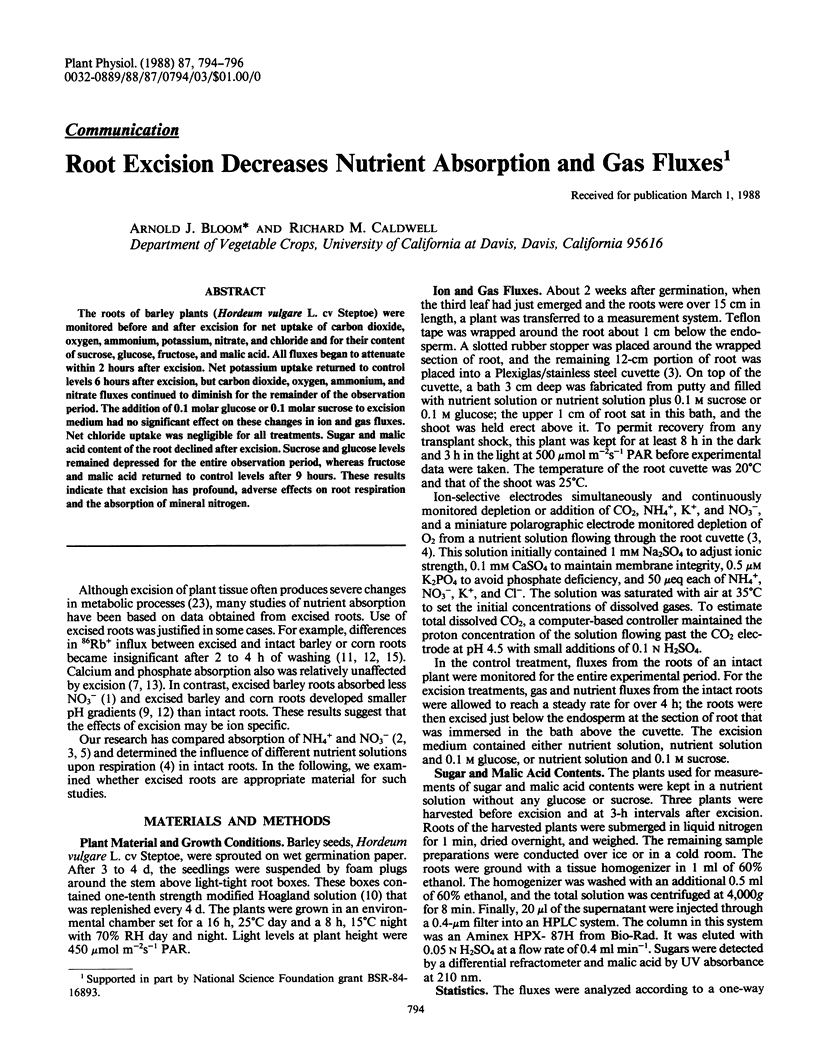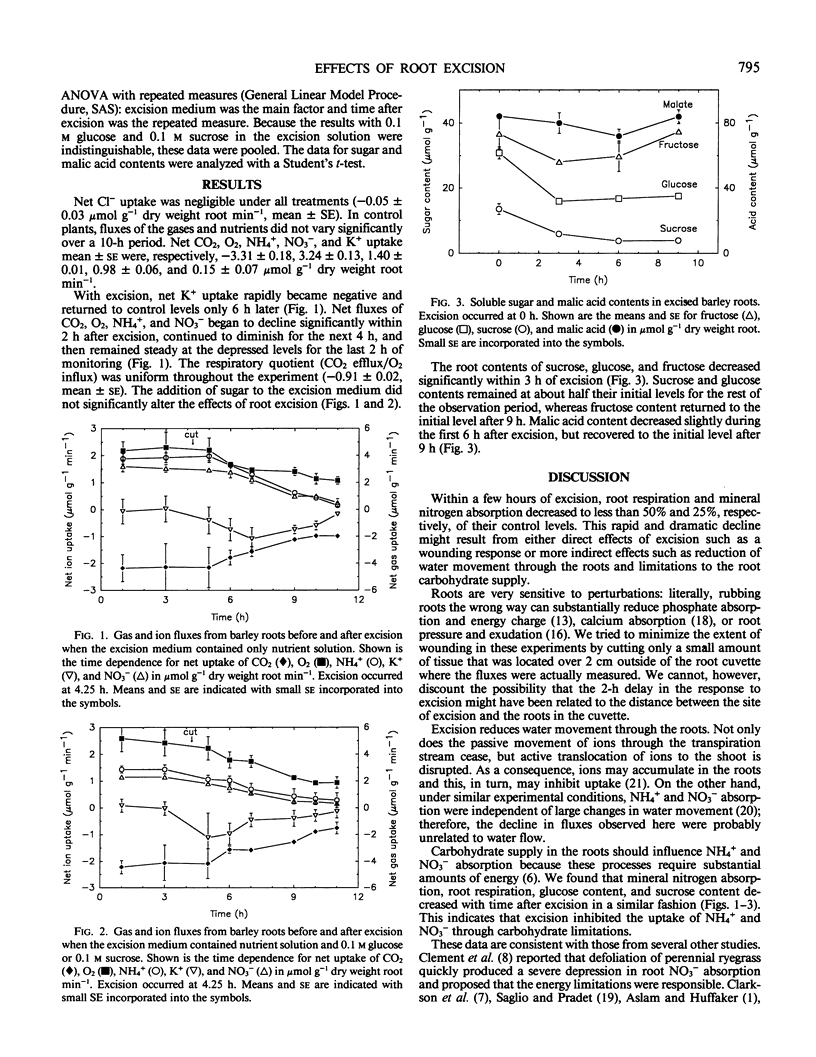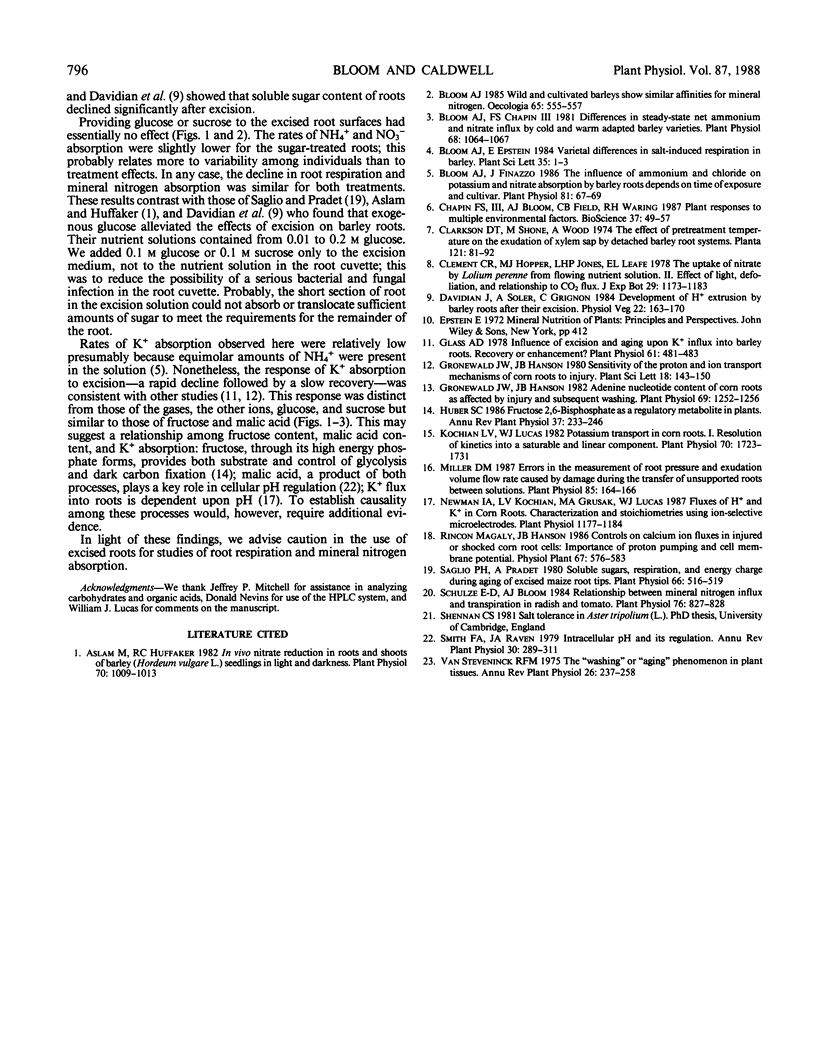Abstract
The roots of barley plants (Hordeum vulgare L. cv Steptoe) were monitored before and after excision for net uptake of carbon dioxide, oxygen, ammonium, potassium, nitrate, and chloride and for their content of sucrose, glucose, fructose, and malic acid. All fluxes began to attenuate within 2 hours after excision. Net potassium uptake returned to control levels 6 hours after excision, but carbon dioxide, oxygen, ammonium, and nitrate fluxes continued to diminish for the remainder of the observation period. The addition of 0.1 molar glucose or 0.1 molar sucrose to excision medium had no significant effect on these changes in ion and gas fluxes. Net chloride uptake was negligible for all treatments. Sugar and malic acid content of the root declined after excision. Sucrose and glucose levels remained depressed for the entire observation period, whereas fructose and malic acid returned to control levels after 9 hours. These results indicate that excision has profound, adverse effects on root respiration and the absorption of mineral nitrogen.
Full text
PDF


Selected References
These references are in PubMed. This may not be the complete list of references from this article.
- Aslam M., Huffaker R. C. In Vivo Nitrate Reduction in Roots and Shoots of Barley (Hordeum vulgare L.) Seedlings in Light and Darkness. Plant Physiol. 1982 Oct;70(4):1009–1013. doi: 10.1104/pp.70.4.1009. [DOI] [PMC free article] [PubMed] [Google Scholar]
- Bloom A. J., Chapin F. S. Differences in steady-state net ammonium and nitrate influx by cold- and warm-adapted barley varieties. Plant Physiol. 1981 Nov;68(5):1064–1067. doi: 10.1104/pp.68.5.1064. [DOI] [PMC free article] [PubMed] [Google Scholar]
- Bloom A. J., Finazzo J. The influence of ammonium and chloride on potassium and nitrate absorption by barley roots depends on time of exposure and cultivar. Plant Physiol. 1986 May;81(1):67–69. doi: 10.1104/pp.81.1.67. [DOI] [PMC free article] [PubMed] [Google Scholar]
- Glass A. D. Influence of Excision and Aging upon K Influx into Barley Roots: Recovery or Enhancement? Plant Physiol. 1978 Apr;61(4):481–483. doi: 10.1104/pp.61.4.481. [DOI] [PMC free article] [PubMed] [Google Scholar]
- Gronewald J. W., Hanson J. B. Adenine nucleotide content of corn roots as affected by injury and subsequent washing. Plant Physiol. 1982 Jun;69(6):1252–1256. doi: 10.1104/pp.69.6.1252. [DOI] [PMC free article] [PubMed] [Google Scholar]
- Kochian L. V., Lucas W. J. Potassium transport in corn roots : I. Resolution of kinetics into a saturable and linear component. Plant Physiol. 1982 Dec;70(6):1723–1731. doi: 10.1104/pp.70.6.1723. [DOI] [PMC free article] [PubMed] [Google Scholar]
- Miller D. M. Errors in the Measurement of Root Pressure and Exudation Volume Flow Rate Caused by Damage during the Transfer of Unsupported Roots between Solutions. Plant Physiol. 1987 Sep;85(1):164–166. doi: 10.1104/pp.85.1.164. [DOI] [PMC free article] [PubMed] [Google Scholar]
- Newman I. A., Kochian L. V., Grusak M. A., Lucas W. J. Fluxes of h and k in corn roots : characterization and stoichiometries using ion-selective microelectrodes. Plant Physiol. 1987 Aug;84(4):1177–1184. doi: 10.1104/pp.84.4.1177. [DOI] [PMC free article] [PubMed] [Google Scholar]
- Saglio P. H., Pradet A. Soluble Sugars, Respiration, and Energy Charge during Aging of Excised Maize Root Tips. Plant Physiol. 1980 Sep;66(3):516–519. doi: 10.1104/pp.66.3.516. [DOI] [PMC free article] [PubMed] [Google Scholar]
- Schulze E. D., Bloom A. J. Relationship between Mineral Nitrogen Influx and Transpiration in Radish and Tomato. Plant Physiol. 1984 Nov;76(3):827–828. doi: 10.1104/pp.76.3.827. [DOI] [PMC free article] [PubMed] [Google Scholar]


